Accounting in real estate - Advanced concepts for keeping your finances on track
If you're in the real estate industry, it's essential to understand the accounting concepts specific to your field. This blog post will discuss some of the most advanced concepts in real estate accounting and explain what you need to know to stay compliant and profitable.
It covers property development accounting, depreciation, amortisation, etc. So whether you're a seasoned pro or just starting in the world of real estate, make sure to read on!
The Beginner's Guide to Real Estate Accounting discusses some fundamental ideas of property development accounting. If you are familiar with the fundamentals, you can proceed to learn more advanced real estate accounting concepts here.
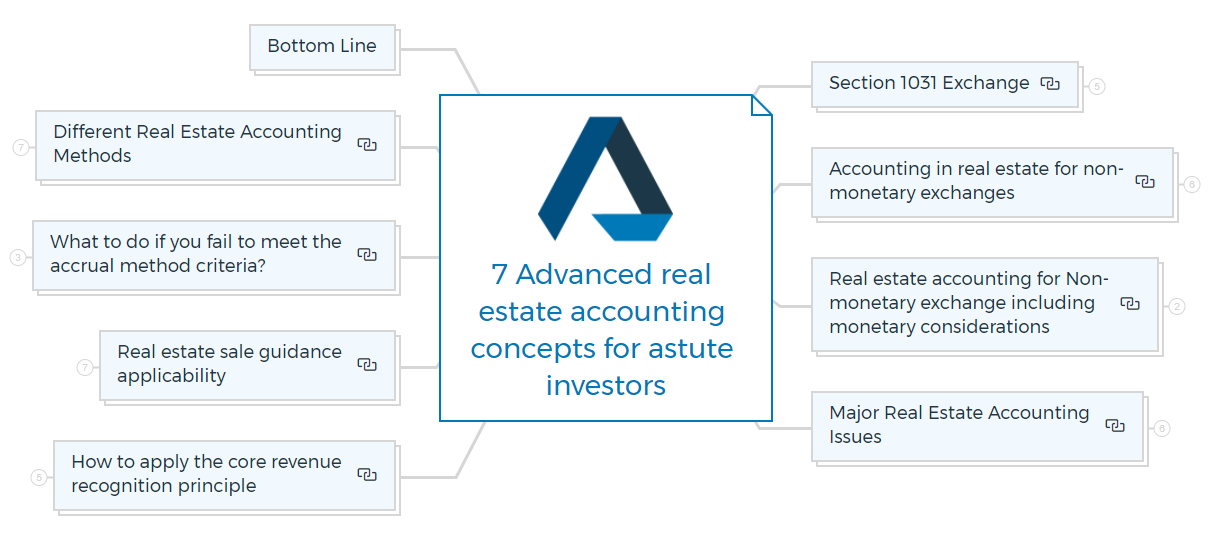
Section 1031 exchange
Non-monetary exchanges of real estate properties are frequently driven by income tax: Section 1031 of the Internal Revenue Code provides an exception to the conventional rule that you must report realized gain or loss upon disposing of property.
Property trades may not change the content of a taxpayer's relative economic situation, according to Section 1031. The replacement property received as part of the exchange is considered a continuation of the previous investment.
The gain or loss on the exchange is not recognized until the property received in the nontaxable exchange is later sold in a taxable transaction. If the properties traded are (1) qualifying properties and (2) of like kind, nonrecognition of gain or loss is required.
Because IRC Section 1031 is essential for real estate exchanges, this article starts with a general explanation of the real estate tax regulations for exchanges before moving on to accounting for real estate consequences of non-monetary property trades.
Section 1031 exchanges come in various shapes and sizes, including multiple-property, deferred, and reverse exchanges. They must meet the requirements of Section 1031, regardless of their structure:
To qualify as a Section 1031 exchange, the transaction must be structured as an exchange, and both the transferred and acquired properties must
(1) be held for productive use in a trade or small business, or investment (known as "qualifying properties"),
(2) be of like kind. You can swap property held for productive use in a trade or business for an investment property, and vice versa, as long as the properties are of like sort.
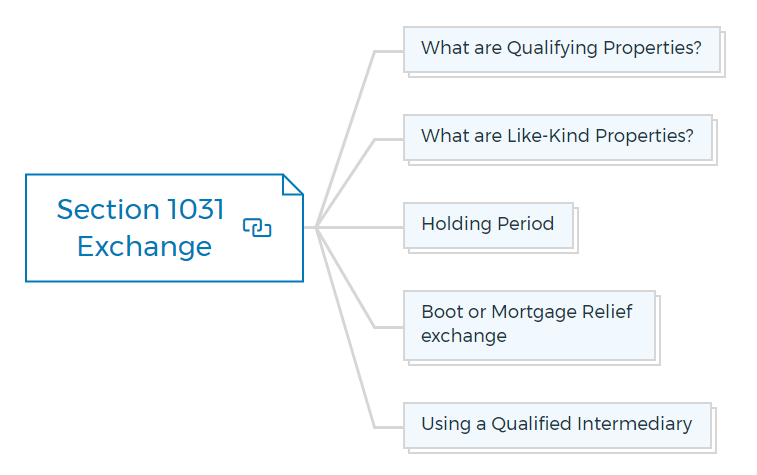
What are qualifying properties?
The following are the four main types of qualifying property:
- Real property
- Tangible property that depreciates over time, such as company equipment.
- Patents, copyrights, and trademarks are intangible non-depreciable personal property.
- Art, antiquities, and coin collections are examples of non-depreciable personal property.
Property held for sales, such as land held in inventory and financial instruments, such as stocks, bonds, notes, other securities, and partnership interests, are expressly excluded from qualified property under Section 1031.
Because it is not used in a trade or company, real estate business used as a principal residence does not qualify for Section 1031 exchange treatment.
What are like-kind properties?
These are properties that are similar to one another. The word "like-kind" relates to the property's nature or character. For example, real estate property cannot be swapped for personal property because their nature and character are not regarded as similar.
It makes no difference if one property is improved (i.e., with roads or buildings) and the other is unimproved in an exchange of two properties to apply Section 1031; the properties are deemed like-kind.
For example, real estate in the United States and real estate outside the United States, on the other hand, are not considered like-kind properties.
Like-kind exchanges are allowed in situations like these:
- A field has been substituted for an apartment complex.
- A hotel is being built in place of an office building.
- Raw land is exchanged for store space.
Holding period
Before you can exchange a property under Section 1031, it must be held for productive business use or investment, such as future appreciation or rental revenue. There are no statutory criteria for holding a property for a specific amount of time to qualify for a Section 1031 exchange.
The Internal Revenue Service (IRS) has decided that property exchanged soon after purchase is not deemed held for investment or income creation.
Boot or Mortgage relief exchange
The boot is any consideration received or provided in exchange for something other than qualifying like-kind property. As a result, the boot includes cash, non-qualifying property, and qualifying property that isn't of like-kind to the property traded.
When boot is given in addition to the real property obtained in the exchange, Section 1031(b) requires a gain to be recognized to the extent of the boot supplied unless the boot given can offset the boot received. The gain is not realized until the property obtained in the exchange is sold in a taxable transaction.
Example - Exchange with boot
ABC real estate business trades a $10 million property for a $4 million property and $6 million cash. The property owned by the company is free of debt. The property has a $4.5 million basis in the company.
Both properties qualify as qualifying properties and are similar. What is the amount of gain that the company must recognize for real estate tax purposes at the transaction time?
The company made a gain of $5.5 million due to the exchange. Because the cash received by ABC ($6 million) exceeds the gain on the sale ($5.5 million), the gain is recognized in its entirety and is thus taxable.
Mortgage relief, sometimes known as mortgage boot, occurs when mortgages encumber the property, and the liabilities are relieved either by repayment or the absorption of the debts by the buyer.
Mortgage relief is handled as cash; it is considered boot. To avoid taxable gains, the taxpayer must either establish or incur new liabilities that equal or exceed the liabilities from which the taxpayer is relieved. The taxpayer must contribute cash to purchase replacement property in the exchange.
Using a qualified intermediary
A transaction must be structured as an exchange to qualify for tax deferral under Section 1031, with the taxpayer relinquishing and receiving property rather than receiving or controlling the sales profits.
A "qualified intermediary" is generally used as a middleman between the parties to the exchange to facilitate the exchange process.
A qualified intermediary is an entity that enters into an exchange agreement with the owner of the property to be relinquished (exchanged), agreeing to receive and transfer (sell) the relinquished property in exchange for the acquisition and transfer of one or more replacement properties to that owner (exchanger).
To be regarded as a qualified intermediary, the intermediary must neither be a relative or agent of the exchanging party nor must the intermediary share more than 10% of the exchanging party's joint ownership.
Example - Mortgage Exchange
ABC company exchanges a property with a fair value of $10 million and a $6 million mortgage for a property with a fair value of $4 million. The property's basis in the company is $4.5 million.
Both properties qualify as qualifying properties and are similar. What is the amount of gain ABC will have to recognize for tax purposes?
On the exchange deal, ABC makes a $5.5 million profit. The total amount of mortgage relief on the deal is $6 million. Because the mortgage relief exceeds the gain on the transaction, ABC will have to recognize the $5.5 million gain for tax reasons.
Example - Netting or Mortgage Boot
Two real estate companies ‘A’ and ‘B’ complete a property exchange transaction. ABC trades a property with a fair value of $25 million, a base of $15 million, and a $12 million outstanding mortgage for a property with a fair value of $26 million and a $13 million outstanding mortgage. B assumes a $12 million mortgage, while A assumes a $13 million mortgage. Both properties qualify as qualifying properties and are similar. B has a $10 million basis in the property sold.
1. What is the amount of gain A will have to recognize for tax purposes?
The total amount of mortgage assistance obtained and given is tallied. A is considered to have paid a $1 million boot. As the payer of the boot, ABC will not be required to recognize any profit.
2. What is the amount of gain B will have to recognize for tax purposes?
B has received a netboot of $1 million, resulting in a $1 million gain being recognized.
If the seller receives the sales proceeds from the sale of the relinquished real estate in a Section 1031 exchange, the transaction becomes taxable.
Boot received directly by the seller as part of an exchange transaction will result in taxable gains, even if the boot is utilized to purchase the replacement property.
However, a qualified intermediary's receipt of sales profits on relinquished property and a qualified intermediary's expenditure of funds to purchase replacement property are not considered receipts or expenditures by the taxpayer.
In a postponed exchange transaction, the involvement of a qualified middleman is incredibly vital. In a deferred exchange, the relinquished property is exchanged in two (or more) stages:
(1) the sale of the relinquished property
(2) the subsequent purchase of replacement property.
Instead of a direct property "swap" between two owners of qualified real estate properties, the deferred exchange will almost usually include a three-party or multiparty exchange.
The replacement property must be "identified" within 45 days of the relinquished property's transfer (closing) in a deferred exchange.
Furthermore, you must complete the exchange within 180 days after the transfer of the surrendered property or the due date of the taxpayer's tax return for reporting purposes.
Accounting in real estate for non-monetary exchanges
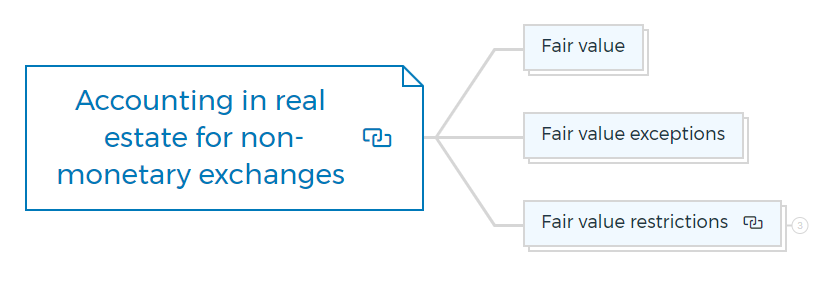
Fair value
While accounting for real estate transactions that are non-monetary assets, fair value is an important principle.
Non-monetary transactions are generally accounted for using the fair values of traded assets or services.
The amount that would be received to sell an asset or paid to transfer an obligation in an orderly transaction between market participants at the measurement date is "fair value."
The cost of a non-monetary item acquired in exchange for another non-monetary asset is the asset's fair value sacrificed to get it. You shall recognize a gain or loss on the exchange.
If the fair value of the asset obtained is more clearly visible than the fair value of the asset surrendered, utilize it to calculate the cost.
Only real estate kept for productive use (such as an office building for rent) was swapped for real estate held for sale in the ordinary course of separate business (such as land inventory) were regarded to "culminate an earning process." That is, only these transactions were subjected to the fair value principle.
The real estate obtained in most real estate swaps was not recorded at fair market value, and the gain on the exchange was not recognized.
This exception to the use of fair value was removed. However, certain exceptions to fair value in non-monetary trades are still allowed under US GAAP.
Fair value exceptions
Unless specific requirements are met, real estate acquired in exchange transactions is measured based on the recorded amount of the real estate asset relinquished, not at fair value.
Fair value restrictions
Suppose any of the below three conditions are met. In that case, a non-monetary exchange of assets is measured based on the recorded amount of the asset relinquished (after reduction for an indicated impairment of value) and not the fair value of the properties swapped.
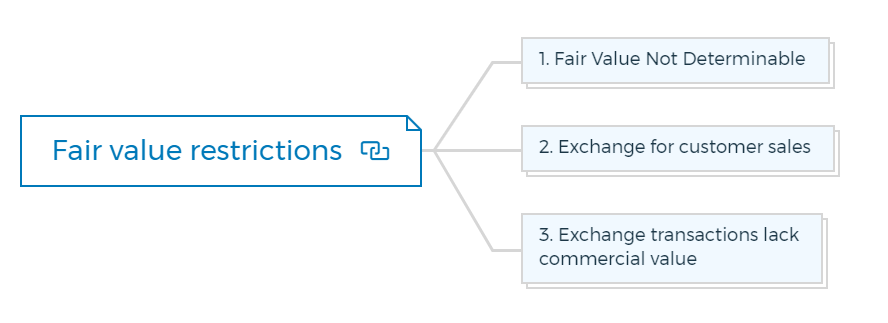
1. Fair value not determinable
Neither the received nor the given asset's fair value is reasonable.
Exchanges of raw land may be difficult to assess if there are no comparable sales.
Raw land, unlike income-producing properties, does not produce cash flows or income that may be used for discounted cash flow analysis for most real estate valuations.
2. Exchange for customer sales
The exchange is of a business asset for another business asset. The transaction facilitates sales to non-exchange parties.
3. Exchange transactions lack commercial value
Earlier, non-monetary swaps were based on recorded amounts rather than the fair value of the assets transferred. Now the "earnings culmination" is replaced with "commercial substance."
A non-monetary exchange has commercial substance if the entity's future cash flows are projected to change significantly. The entity's future cash flows will shift dramatically if these criteria are met.
a. The future cash flows of the assets received differ in risk, time, and amount from the assets transferred.
b. The entity-specific value of the assets received differs from that of the assets transferred, which is significant.
Entity-specific value aims to capture an asset or liability's value to a single entity. An entity calculates the entity-specific value of an asset based on its expected usage, not market participants'.
As real estate properties differ in risk, timing, and future cash flows, many transfers have commercial substance.
Real estate accounting for Non-monetary exchange including monetary considerations
Real estate exchange transactions that contain monetary consideration are separated into a monetary exchange treated as a sale, and a non-monetary exchange accounted for under Topic 845.
The monetary versus non-monetary element percentage depends on comparable fair values at the exchange date.
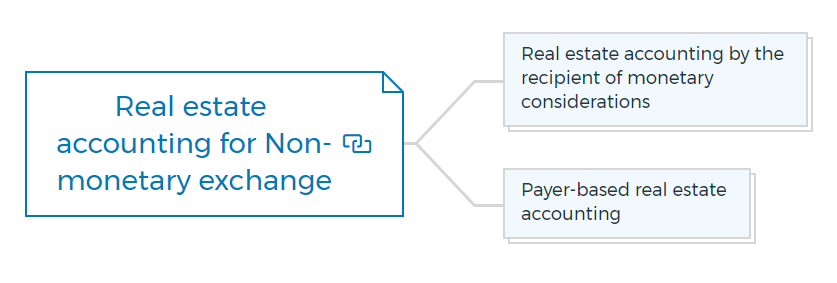
Real estate accounting by the recipient of monetary considerations
For the recipient of monetary consideration, the monetary element is accounted for real estate as the sale. The exchanged property is recorded at fair value unless a condition precludes it.
Example - Determining monetary exchange portion
ABC buys $2 million in real estate from XYZ. XYZ receives $400,000 cash, a $400,000 note, and $1.2 million in property. XYZ values the property transferred to ABC at $800,000.
What's the transaction's monetary and non-monetary portion?
The monetary portion of the deal is 40%, meaning $400,000 cash and $400,000 note divided by $2 million. The non-monetary element of the transaction represents 60% of the overall fair value of the trade ($1.2 million).
Example - Real estate accounting by the receiver of monetary consideration
This example continues the previous one: Determining the monetary exchange portion.
For this example, it is assumed that the non-monetary exchange transaction does not meet the fair value criteria and that the monetary portion meets the accrual method criteria.
Questions
1. How much gain will XYZ company realize?
2. What is the ABC acquisition basis?
Answers
1. Gain:
Monetary portion. The gain on sale is the cash received minus the proportional book value of the property exchanged. XYZ will make $200,000 on the sale of real estate.
$800,000 monetary compensation ($400,000 cash and $400,000 note) less $600,000 book value of real estate (40 percent of $1.5 million book value transferred).
Nonmonetary. XYZ will not recognize a gain on the sale of the non-monetary element of the transaction because it does not meet the conditions for being recognized at fair value.
2. Acquisition accounting in property development
Non-monetary trade gives XYZ $1.2 million in real estate. The non-monetary exchange element of the property's book value is $900,000 (60 percent of $1.5 million).
As the non-monetary exchange property doesn't meet the standards for fair value recording, it's recorded at its carryover basis of $900,000.
Payer-based real estate accounting
If the exchange transaction qualifies for fair value recording, the buyer records the property at fair value. Fair value is the sum of cash paid, and the fair value of the real estate exchanged or the fair value of the real estate received.
If one party could have gotten cash instead of the real estate, the amount of cash could be evidence of the property's fair value. If the exchange transaction is not recorded at fair value, the real estate acquired is documented at cash paid plus the carrying amount of the real estate asset transferred.
Example - Real estate accounting by the payer of monetary consideration
Example continuous from the Determination of Monetary Exchange Portion.
In this case, the non-monetary exchange transaction is not recorded at fair value. How would ABC record the exchange transaction?
ABC wouldn't recognize gain. The property cost $1.6 million. This amount is calculated as:
Monetary Portion
The transaction involves $800,000 ($400,000 cash and $400,000 note) to buy real estate.
Non-monetary portion
ABC registers the exchanged real estate at $800,000 as the carrying amount.
Major real estate accounting issues

Exchange-Leaseback
In an exchange-leaseback deal, the "seller"-lessee exchanges real estate assets for those of the "buyer"-lessor and leases back the transferred real estate.
When assessing an exchange-leaseback transaction, determine if ASC 840-40-25-9 sale-leaseback accounting conditions are met.
Sale-leaseback accounting in property investment is only suitable if exchange-leaseback includes :
- Standard leaseback (active use of the property)
- Initial and ongoing investments
- All risks and rewards of ownership are transferred, and the seller-lessee has no other role.
In a real estate exchange, adequate initial and continued investments in the properties acquired are not a problem since the real estate received replaces the buyer's cash payments.
Suppose the conditions for sale-leaseback accounting are not met. In that case, the seller-lessee continues to carry the exchanged property on its books and accounts for it using the deposit method or as a financing transaction.
The seller removes the property transferred in the exchange from its books if the sale-leaseback accounting criteria are met. The seller-lessee then uses Topic 845 to decide whether the real estate obtained through the exchange transaction should be accounted for on a fair value or carryover basis.
Gains from the exchange transaction are deferred and amortized over the lease period in the same way that gains from a sale-leaseback transaction are deferred and amortized over the lease term.
Property Development Checklists
Stop Second-Guessing Yourself
POWER BUNDLE
Finally! A way to Free your mind from worrying
about every possible expense that could derail your project.
3 x Powerful & Detailed Checklists
Compiled Over 10 Years Of Hands-On Experience
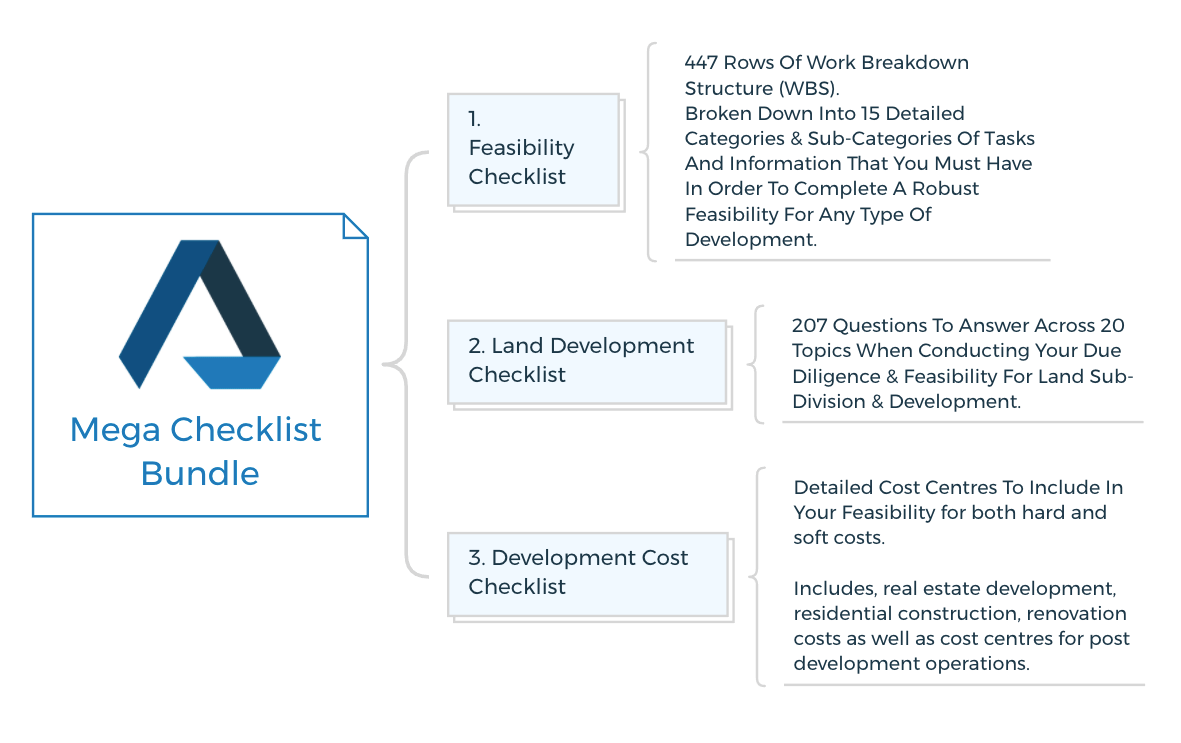
Mega Checklist bundle
✓ Feasibility Checklist
✓Land development checklist
✓Development, Construction & operational Costs Checklist
✓ 447 Rows Of Work Breakdown Structure
✓ 232 Costs To Consider Just On the Developer Side
✓ 524 Cost centres to consider on the construction & remodelling side
✓ Detailed operational costs
✓ 26 Revenue & 78 Expense Items To Consider
✓ Commercial (Retail, Office and Industrial) Side
✓ 31 Revenue & 138 Operating expense heads to consider
Related-party transactions
1. Non-monetary transfers between firms or people under common ownership, such as:
- Parent and subsidiary
- Two-parent subsidiaries
- A joint venture's owners
2. Acquisition of non-monetary assets or services on an IPO.
3. Asset transfer for an equity stake.
Comprehensive, authoritative guidance on exchange transactions between a corporation and its owners, common-control entities, and related parties is inadequate. Determining the proper foundation for a non-monetary asset and whether to recognize gain are common difficulties.
Owner nonreciprocal transfers
In-kind distributions to owners are generally recorded at the fair value of the non-monetary assets transferred with a gain or loss recognized on the asset's disposition.
Assuming the fair value of the non-monetary assets is objectively measurable and would be realizable to the distributing entity in an outright sale.
Suppose a corporation buys outstanding shares (for treasury or retirement) by transferring assets to its shareholders. In that case, the fair value of the firm's reacquired stock may be a more unambiguous indication of the assets dispersed and should be used to record the exchange.
If the fair worth of distributed non-monetary assets is not objectively observable, the transfer is accounted for in the recorded quantities.
The standard rule of documenting asset transfers at fair value is not observed in a spin-off, reorganization, or liquidation. If lower, transfers are recorded at the assets' reported amounts or fair value.
Spin-off asset transfers
An organization may reorganize using a spin-off. An entity may transfer assets into a new legal spun-off entity and distribute its shares without shareholders surrendering spinor stock.
Example - Spin-Off:
A Retailer owns a mall and its anchor store. Two sections administer the mall and store. Retailer's stockholders separate the company so each can focus on its operations. Retailer transfers the mall's assets and activities to a new company, Mall Company, and distributes its shares on a pro-rata basis to its shareholders.
The transaction is Spin-off.
Common-control asset transfers
Real estate transfers between entities under shared control, between a controlling shareholder and a corporation, or between subsidiary and parent are often deferred until the assets leave the controlled group. The real estate exchange is valued based on the asset relinquished.
The receiving entity records the asset at the transferor's carrying amount. In cases where the real estate transferred in the exchange is damaged, the author considers that the transferor should recognize a loss in value, and the transferee should record the real estate received at fair value.
Joint venture partners' non-monetary asset transfers
Real estate industry partners often give the land. The proper accounting depends on the transaction and conditions.
A full or partial step-up in basis is usually not permitted in real estate exchanges for equity interests in creating a joint venture unless the transfer involves a partial sale. Post-formation contributions to a joint venture are recorded at fair value.
How to apply the core revenue recognition principle
Here are 5 significant steps to apply the core revenue recognition principle in real estate accounting -
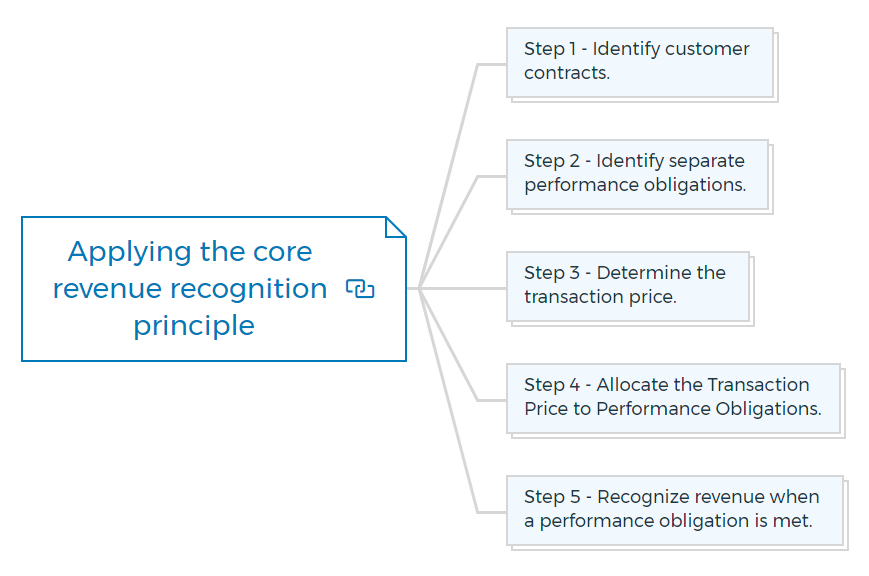
Step 1 - Identify customer contracts.
Step 1 involves contract segmentation and combination. If the prices of multiple contracts are interconnected, an entity may account for them jointly.
Based on the boards' provisional judgement, a company should combine two or more contracts with the same client and account for them jointly if these criteria are met:
- The contracts are negotiated with a single business goal.
- One contract's consideration depends on another.
- Design, technology, or function link the contracts' goods and services.
Step 2 - Identify separate performance obligations.
Step 2 outlines performance obligations in real estate accounting. In some contracts (e.g., construction contracts), an entity promises a bundle of associated commodities or services and integrates them into the contracted item(s). The entity should account for the bundle as a single performance obligation in these circumstances.
An entity should account for a promised good or service as a separate performance obligation if (a) it is distinct and (b) its pattern of transfer is different from other promised goods or services in the contract.
Step 3 - Determine the transaction price.
The transaction price in real estate accounting is the amount an entity demands from a customer for goods or services. The transaction price should represent the entity's probability-weighted estimate of variable consideration (including acceptable estimates of contingent amounts), customer credit risk, and time value of money.
Step 4 - Allocate the transaction price to performance obligations.
If there are multiple performance obligations in the real estate business, step 4 deals with allocating the transaction price. An entity allocates the transaction price to all independent performance commitments based on the stand-alone selling price of each good or service. If the good or service isn't sold separately, the company estimates its selling price.
Step 5 - Recognize revenue when a performance obligation is met.
When an entity fulfills a performance obligation, it records revenue.
- Goods. When the customer receives the products, an entity recognizes revenue.
- Service. An entity recognizes revenue from services when the performance requirement is met.
The proposed standard lacks clear guidelines like GAAP's real estate sale guidance. The new revenue standard covers some forms of continuous seller engagement that prevent accounting as a sale or impact profit recognition.
Collectibility of the sales price, another critical concern under current standards, will impact proposed revenue recognition.
Before leaving ineffective guidance, two proposed points are worth mentioning:
- Condominium sales will no longer be recorded using the percentage-of-completion approach.
- The concept of a continual transfer of products or services is introduced.
Real estate sale guidance applicability
Real estate sales, including upgrades and equipment. Property improvements and integral equipment refer to any construction or equipment attached to real estate that you can't remove without significant expenditure.
Offices, factories, power plants, and refineries are examples.
When the cost of removing and reinstalling equipment exceeds 10% of its market value, it's termed integral.
When assessing whether the nature of the assets being sold is, in essence, the sale of real estate, the attributes of the combined assets being sold (i.e., the manufacturing facility, the power plant, plus the land, receivables, payables, and so on) must be evaluated.
The sale of timberlands or farms (i.e., land with trees or crops) is similar to the sale of land with property improvements or integral equipment and hence subject to real estate sale instructions.
Oil, gas, coal, and gold extracted from the land are not subject to real estate sale provisions. The sale of timber or harvested crops (i.e., anything separated from the land when it reaches the buyer) is not subject to real estate accounting regulations.
A marketable investment in a real estate entity, such as a real estate investment trust (REIT), is not considered an investment in real estate.

Sale and Profit recognition
Two concerns occur when evaluating a sale transaction in real estate accounting :
- Should the transaction be recorded as a sale or a purchase?
- What technique should you use to recognize profit on the sale?
A real estate sale transaction cannot be reported as a sale until it has been completed, which involves meeting four criteria:
- Contracts bind parties.
- The entire sum of money has been swapped.
- The seller has acquired permanent financing.
- Closing requirements are met.
These four conditions are generally met at closing or after closing, not when a sales agreement or pre closing is executed. In rare cases, a sale can occur before closing.
Suppose the trustee has received all sale consideration and the property's title, but the closing process has not been completed. In that case, a sale may be registered when title and consideration are obtained.
Profit recognition by the accrual method of real estate accounting
Under the real estate accounting accrual method, a real estate sale's profit is recognized, not deferred. The accrual real estate accounting technique has several conditions.

1. General rule
When the below two conditions are met, a real estate sale's profit is fully recognized.
1. The profit is determinable, meaning you can estimate the collectability of the sales price. Collectability of the sales price is shown by the buyer's commitment to pay, which involves considerable initial and ongoing investments that provide the buyer with a stake in the property enough that the risk of loss through default stimulates the buyer to honor its obligations to the seller.
When determining the collectability of the sales price, consider criteria like the buyer's credit, the property's age and location, the buyer's financing arrangements, and the property's cash flow.
2. The seller doesn't have to do much after the sale to earn a profit.
Unless all conditions are met at the moment of sale, the profit must be delayed.
2. Details
The accrual real estate accounting approach doesn't recognize a sale's profit unless all of these conditions are met:
- Initial and ongoing investments show the buyer's resolve to pay.
- Seller's receivable isn't subordinated.
- The seller has transferred the risks and rewards of ownership to the buyer in a sale, and the seller has little ongoing involvement with the property.
Adequate initial and ongoing investments
The real estate accounting accrual approach demands that
- The profit be determinable,
- The collectibility of the sales price
must be reasonably ensured.
Collectibility of the sales price is proved by the buyer's commitment to pay, which is reinforced by significant initial and continuous investments that provide the buyer with a stake in the property sufficient to compel it to honor its duty to the seller.
There is a minimum threshold for initial and continuing investments for accrual method profit recognition in accounting for real estate. These rules measure the buyer's investment, not the seller's cash.
Thus, a buyer's payment to pay off property debt is included in initial and ongoing investments. Comparing the property's sales value to the buyer's initial and continuing investments determines sufficiency.
Sales value
The buyer's original and continuing investments are compared to the real estate's sales value, not its sales price.
You can determine the sales value of the real estate by modifying the sales price for any additional proceeds to the seller that are in substance additional sales proceeds and for any monies included in the sales price that represent future services or interest on a below-market note.
Calculation of sales value
Sales price
Plus: Exercised real estate option proceeds
Plus: Other sales-related payments, such as:
- Property management fees
- Prepaid interest
Less: Discount receivable to present value
Less: Net present value of seller-performed services
Less: Value of services over compensation
Sales Value is the sum of the above.
Initial and ongoing investments
When analyzing the buyer's initial and continuing investments, one must analyze the buyer's consideration (its composition) and the magnitude of the investments (their sufficiency).
Considerations for qualified initial and continuing investments.
- Down-payment cash
- Buyer's notes backed by irrevocable letters of credit from a reputable lender
- Buyer payments to decrease property debt
- Other buyer payments are included in the sales price.
All other consideration received by the seller, including buyer notes, is included in the buyer's initial investment when the consideration is sold or converted to cash without recourse to the seller.
What to do if you fail to meet the accrual method criteria?
If a sale is completed but does not meet the criteria for profit recognition using the accrual method, several real estate accounting procedures are applied, depending on the reason.
When more than one issue prevents real estate accrual accounting, you should consider all of them.
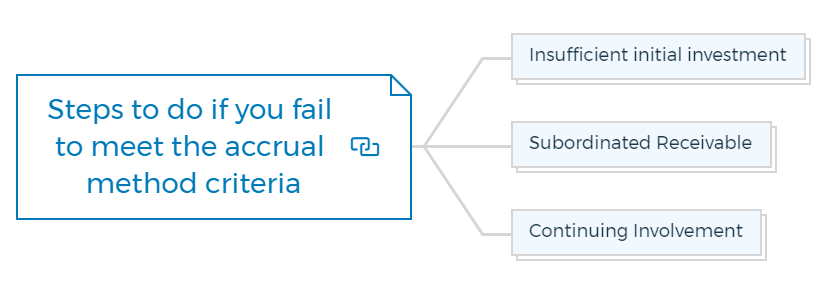
Insufficient initial investment
Suppose the buyer's initial investment doesn't match the conditions for profit recognition via the accrual method. In that case, the profit recognition method depends on whether the cost of the property may be recovered if the buyer defaults:
Instalment or cost recovery is acceptable to recognize profit if the buyer defaults. If the buyer defaults or the cost has already been recovered and extra amounts are undetermined, use the cost recovery or deposit method.
Inadequate continuing investment
In a situation where the initial, but not the continuing, investment meets the conditions and all other criteria for the accrual method have been met, profit is recognized under the reduced profit method at the time of sale if buyer payments cover both of these amounts:
- Maximum first mortgage loan interest and principal amortisation
- Interest on the excess of the property's real debt over the maximum initial mortgage amount.
If these criteria for the reduced profit technique aren't met, you should use the instalment or cost recovery approach.
Subordinated receivable
If the seller's receivable is subordinated, you can calculate profit using cost recovery.
A receivable subject to future subordination does not preclude the use of accrual accounting if
(1) That receivable is subordinate to a first mortgage on the property at the time of sale.
(2) The terms of the sale provide for a loan, the proceeds of which are applied first to the seller's receivable.
Continuing involvement
If the seller remains involved in the property and does not transfer most of the risks and rewards of ownership, all profit is usually not recognized. The seller's continuous engagement determines whether a transaction can be recorded and, if so, how much profit to recognize.
If the seller's loss of profit due to prolonged participation with the property is restricted by the sales contract, it is ordinarily permissible to record profit; however, the profit is reduced by the maximum exposure to loss.
Continuing involvement affects how a sale is accounted for, for which you may mandate alternative accounting methods for sales transactions involving multiple forms of continuous involvement.
In that scenario, the proper method requires judgement. When arranging a deal that exposes the seller to loss contingencies, the seller should include a clause in the sales contract that restricts the seller's duty so the seller can recognize a profit.
Different real estate accounting methods
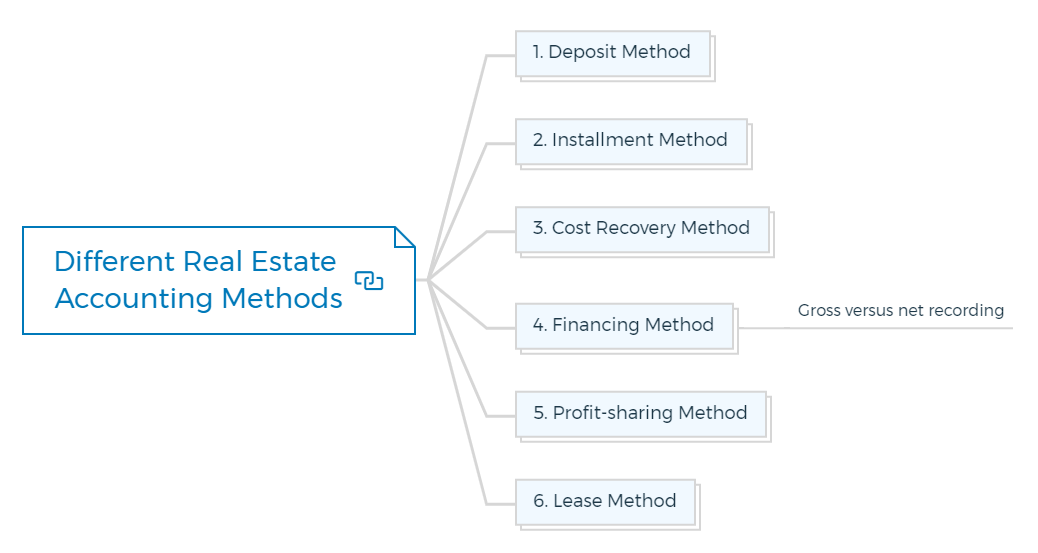
1. Deposit method
When no sale has occurred, use the deposit accounting method. The seller's down payment is nominal and has no skin in the game, or not all closing conditions have been met; therefore, the sale is not consummated.
- In this method of real estate accounting, the seller doesn't recognize a sale.
- Even though the buyer has assumed the seller's debt, the seller continues to record the property and accompanying debt in its financial reports and declares a sales contract.
- Principal payments made by the buyer on assumed debt are reported as debt reduction and buyer deposits.
Unless the property is a long-lived asset classed as held for sale, the seller continues to record revenues, costs, and depreciation. Long-lived assets kept for sale aren't depreciated, but interest and other business expenses continue to accrue.
2. Instalment method
In this accounting method, the seller recognizes a sale. Sold property and buyer debt are erased from the records. You can use the instalment approach when the initial and continuing investment does not qualify for the accrual method.
- The property's carrying amount has been recovered or is reasonably assured if the buyer defaults.
- If the transaction fits the conditions in a subsequent period, the seller may switch to it. Unrealized profit from the instalment approach is then recognized.
- The instalment system defers sales profits until cash is collected.
Each cash receipt (including the main payment by the buyer on debt acquired) is divided between cost recovered and profit in proportion to sales value.
Under instalment real estate accounting, interest income is recognized as received, not accumulated. If the seller funds the sale with a below-market note, they must establish if market-rate financing would have resulted in a loss.
A seller must guarantee that a sale receivable, excluding unrecognized profits, does not exceed the property's carrying amount had it not been sold.
For a transaction with little down payment, a seller must compare the buyer's receivable to the "hypothetical" depreciated book value of the property to see if these criteria are met.
3. Cost recovery method
Cost recovery, like the installment method, records a sale. The cost recovery technique does not allow profit on sale or interest income until the buyer's interest and principal payments match the property's carrying price, including payments on assumed debt.
- All payments from the buyer to the seller are credited to balance sheet accounts until the carrying amount is recovered.
- After cost recovery, subsequent payments are credited to income.
- Real estate losses are realized upon sale.
Choosing between cost recovery and installments requires discretion. In case of a buyer default, the seller must assess if the property's carrying amount is recoverable.
If the buyer defaults, cost recovery is used. It may happen if the seller has no lien on the property after the sale or if their receivable from the buyer is subordinate to other liens.
If the transaction fits the accrual method requirements in subsequent periods, the seller might switch to it and record the remaining profit as income.
4. Financing method
The financing approach of real estate accounting is applicable when the transaction is not a sale but a loan secured by the property sold. Financing is also acceptable for continued involvement, such as a seller's long-term guarantee.
- No sale is recorded under this method. The seller continues to report the property's activities and any debts assumed by the buyer.
- If a sale qualifies for sale recognition, it's recorded.
- Any property operations (other than depreciation) not accruing to the seller should be offset by an increase or decrease in interest expense, consistent with a participating mortgage loan borrower's accounting.
A real estate sale that does not initially qualify for sale recognition must not result in a "scheduled loss" when it does qualify for sale recognition.
Gross versus net recording
Views differ on whether a seller should record the transaction "gross" or "net,".
Net Recording: When the seller record the cash received and a corresponding financing obligation.
Gross Recording: In addition to the cash received—the seller also records a note from the buyer.
It's argued: In a financing transaction, a property owner receives cash from a lender. The property owner should record a loan in the amount of cash received; any note from the buyer does not fit within a financing transaction and should not be represented on the seller's balance sheet.
- Consideration from the buyer can include cash and a note (or other principal assets).
- A buyer's note is a legal obligation the seller can monetize.
If there is no opportunity or obligation to repurchase the property, the financial transactions may not constitute a "loan" secured by real estate.
Most financing method deals follow "net recording," which is consistent with failed sale-leaseback transactions.
5. Profit-sharing method
Real estate transactions often feature venture arrangements in which two or more parties undertake a real estate project or sell land to one other and share future profits.
These ventures may entail a separate legal entity. If the seller's involvement prevents sale accounting, there may be a use of the profit-sharing real estate accounting process. Profit-sharing is applied by:
- The seller records a "profit-sharing obligation" or "co-venture obligation" for any consideration received from the buyer/venture partner.
- The seller keeps recording depreciation and property operations.
- The income statement caption "profit-sharing expense/income" or "co-venture expense" or "co-venture income" lists the buyer/venture partner's income and expenses.
Buyer/venture partner and seller may agree to pay for property management services, operations, or property sale profits.
Because the property's operations are recorded on the seller's books, you must examine all buyer-seller arrangements for their impact on the financial records. Payments between parties can increase or decrease costs.
6. Lease method
Real estate sales can be leases. Leasing is frequently acceptable when the seller may repurchase the property for less than the buyer paid.
Under leasing, the seller keeps the property and any related debt on its books and reports operating performance. Buyer cash is recorded as a liability.
The difference between the repurchase price and sales price under the leasing system constitutes prepaid rent, straight-lined into income.
The liabilities account equals the property's buyback price when "lease income" is recognized.
Example - Leasing Method
Company A sells a warehouse to company B for $5 million at the start of Period 1 and agrees to acquire the warehouse for $3 million at the end of Period 5.
How should A account for the transaction?
In essence, the deal is a $2 million prepaid rental lease. The property and associated debt are still on A's books. Throughout the lease, B's rental revenue is straight-lined. In periods 1 through 5, the seller records $400,000 in rental income.
Bottom Line
Accounting has always been an important aspect of real estate and other businesses. Without accounting, business development is difficult to assess.
Without accounting knowledge, complying with local legal entities is difficult. Don't neglect your bookkeeping when building your real estate firm.
Make sure you're up-to-date on the latest real estate sale guidance and accounting methods so you can stay ahead of the competition and get the most for your property. Use the smart development feasibility suite to ensure that your revenue is recognized in the correct period.
FAQs
What is real estate investment accounting?
Real estate investment accounting is the specialized industry accounting used by real estate investors to keep track of their investments. This type of accounting focuses on the financial aspects of owning and operating real estate properties, such as income from rent and expenses for repairs and upkeep.
Real estate investment accounting is important for two main reasons. First, it allows investors to track their progress and performance over time. This information can be used to make changes to future investment strategies based on what has worked (or not worked) in the past. Second, it provides a way for investors to measure how well their properties are performing relative to other investments. This information can help them make decisions about whether or not to sell a property or make changes to its operation.
How is fair value calculated in accounting?
In accounting, fair value is the estimated worth of a certain asset. This figure is used in order to assign a monetary value to an asset for financial reporting purposes. The calculation of fair value often revolves around the present market value or replacement cost of an asset. Factors such as age, condition, and supply and demand can all affect an asset's fair value. Thus, coming up with a single figure that accurately represents the fair value of an asset can be difficult and may require professional appraisal. However, once calculated, this figure provides valuable information for both businesses and investors alike.
What is accrual system of accounting?
The accrual system of accounting is a method of bookkeeping in which revenue and expenses are recognized when they are earned or incurred, regardless of when the cash is actually received or paid. This system is used by businesses and governments around the world.
The main advantage of the accrual system is that it provides a more accurate picture of a company's financial health, because it recognises revenues and expenses as they happen, rather than when the cash actually changes hands. This helps businesses make better-informed decisions about their finances.

